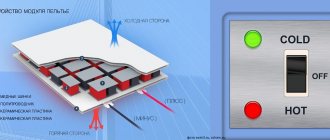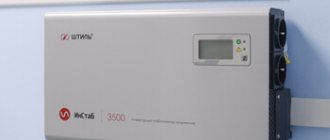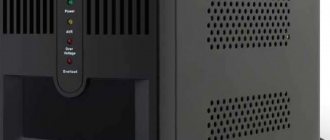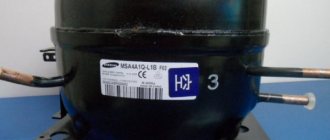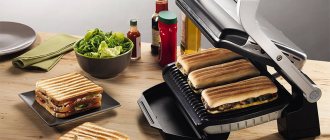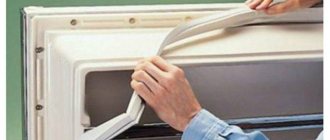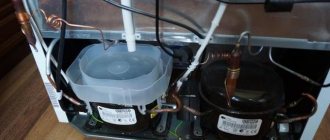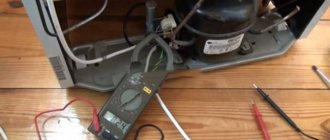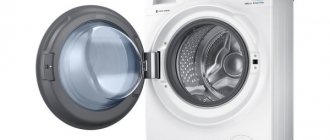If the voltage in our networks met the requirement of 220 V and +/- 10% in both directions, there would be no need to improve its characteristics. Home appliances, including refrigeration equipment, especially suffer from power surges. A voltage stabilizer for a refrigerator is needed to protect an expensive unit.
You will learn everything about choosing a device to protect a refrigeration machine from an unstable power supply from our article. We will talk about the types of devices and the rules for choosing them. Taking our advice into account, you can install surge protection yourself and extend its service life.
The importance of stabilizer in protecting a refrigerator
No matter what the latest technologies manufacturers use, no matter how many additional options the unit has, it is connected, like its simplest predecessor, to the same 220 V outlet. The input voltage in our networks is far from the best quality.
And the refrigerator is designed in such a way that its individual components are able to function normally only at a voltage with normal parameters. Voltage surges are especially dangerous for such an important element of the refrigerator as the compressor.
Its design includes a board responsible for regulating the cooling process, which is the most vulnerable point. As a result of a sudden increase in voltage, this expensive element may fail.
A voltage stabilizer is needed when operating a refrigerator connected to a network with characteristic voltage surges. For example, when connecting to old networks or a diesel generator
For the windings of an electric motor, both the long-term presence of low voltage and the long-term influence of a large starting current are dangerous due to the protracted process of activation at a low voltage. As a result of exposure to high temperatures on the windings, insulation melting is likely to occur.
Voltage correction is required not only for modern refrigeration equipment. Refrigerator models that were produced a long time ago are not equipped with protection against premature start-up.
Therefore, when the voltage is turned off and then abruptly turned on, the crank-slide pair of the compressor suffers as a result of water hammer in the space available above the piston. The stabilizer will turn off the power when the output voltage reaches its maximum, providing a time delay before the next start of the compressor.
Like other household appliances, food refrigerators are designed to operate continuously at normal voltage. When the voltage in the network has a significant difference from the nominal value, you cannot do without a stabilizer
Before deciding to purchase a stabilizer, you need to make sure the purchase is appropriate. To do this, you should study the parameters of the existing electrical network. It is recommended to measure the network voltage over several days during peak consumption.
It is advisable to use devices that record the current voltage. Foreign manufacturers designate this function as True PMS. If, based on the measurement results, it turns out that the controlled parameter did not exceed the limits of 205-235 V, a stabilizer will only be required for a new, expensive refrigerator model.
Its elements are especially sensitive to changes. The situation is considered critical when voltage deviations in the direction of increase exceed +10% or -15% in the direction of decrease.
According to the instructions of GOST number 32144-2013, indicated in paragraph 4.2.2, during voltage surges of up to 10%, a stabilizer is not required for the operation of the refrigerator. That is, when supplied by an alternating voltage network in the range of 198 - 242 V, the device may not be used for stabilization
In this case, connecting a stabilizer is a must. Most new models are equipped with built-in voltage stabilizers.
Their reliability is questionable, because... in practice, they do their job poorly when the network is heavily overloaded. In a critical situation, they themselves may become damaged and the unit will be left completely unprotected.
How to make the right choice?
The correct choice of stabilizer will help eliminate this unfavorable scenario. Some models are ideal for overvoltage situations, while others are more effective at boosting voltage in the event of a voltage drop or coping with network interference.
At increased voltage
Relay voltage stabilizers are indispensable for equalizing high voltages that last for a long time. However, they are not able to quickly track changes with frequent and sudden changes in this parameter. A triac stabilizer can handle fast voltage surges.
At low voltage
If low voltage is constantly observed at the facility, it is optimal to use an electromechanical type of stabilizer. It is also used in autonomous power supply systems with a large number of household appliances that cause a voltage drop when turned on at the same time.
High voltage interference
Each stabilizer by default contains circuits for filtering the input voltage from RF and LF interference with galvanic isolation. However, during a lightning strike or in an emergency, consumers may be supplied with increased voltage, which can damage the input circuits of the stabilizers. For example, if the “zero” in the line breaks, 380 V is supplied to consumers. Therefore, for reinsurance, a voltage relay is additionally installed on the electrical panel.
Types of stabilizers for refrigerators
Devices designed to stabilize voltage differ in both design, output power, and operating principle. Based on these characteristics, there are three types of refrigerator stabilizers: electromechanical, also known as servo drive, relay, triac or electronic.
The photo shows all three types of stabilizers: servo drive - the cheapest, relay, electronic - the most reliable, stable, but also expensive
Stabilizers are also divided by type of electrical network. They can be single- and three-phase. The first ones have compact dimensions, and since There is no cooling fan in their design; they make almost no noise during operation. The output voltage is monitored continuously, but the level of response to the input voltage is quite low.
For houses powered by a 380 V power supply, three-phase stabilizers have been developed that are designed for heavy loads, but when one of the phases fails, the protective mode does not work. Depending on the type of voltage in the network, devices are divided into those operating with low, high and intermittent voltage.
Electromechanical type devices
Servo-drive devices control the pantograph drive and monitor voltage parameters via an electronic board. High accuracy is their main advantage; the error is only 2-4%. The disadvantage is the speed caused by the inertia of 10-20 volts.
Electromechanical stabilizer - view from the inside. The slider, moving along the turns of the winding, changes the output voltage. A large number of nodes makes such devices short-lived
Such a stabilizer works well under conditions of either slowly changing voltage, or consistently low, or high voltage. If there are strong abrupt changes, the device will quickly become unusable. Such conditions are most often observed in dachas and country cottages, so this option is not suitable here.
Relay type stabilizer
A simple relay type stabilizer control system can withstand significant differences. On its electronic unit, as well as on the controller, there are power relays, which are responsible for switching the transformer windings. The transition occurs extremely quickly - in just 0.5 seconds.
The photo shows a relay type stabilizer. This equipment is the most common in everyday life. Often consumers are attracted by its relatively low cost
The weak link is the microcontroller. It can burn out if it cannot withstand the excessive mobility of the input voltage.
The work of switching transformer stages is accompanied by clicking noises, which does not add comfort to the home. Such models are intended for use in networks where rapid voltage reboot occurs constantly.
System models of devices
There is no such element as a relay in the electronic stabilizer; the control is managed by semistors, which quickly respond to the slightest changes in the network. The absence of mechanical contacts makes it possible to carry out multiple switching noiselessly during power outages.
Thyristor stabilizer SKAT ST-12345. It covers a wide range of input voltages, is characterized by high power and stabilization speed, and complies with all domestic and international standards
They can withstand voltage overloads of up to 20% for 12 hours, and up to 100% for one minute. Manufacturers of system stabilizers place high demands on the quality of parts and assembly accuracy, so both the durability and cost of the devices are appropriate.
Which is better – a surge protector or a stabilizer?
Simple network filters are built on inductive-capacitive single-link LC stages.
More complex designs are implemented using semiconductor varistors with auxiliary elements of the electrical circuit. They convert the energy of “parasitic” pulses into dissipated heat. Surge filters are “sharpened” to eliminate only low-power short-term (duration 10−6-10−9 s) industrial and lightning impulses on power lines entering the 220 V network. They are also able to cope with interference induced in the network wiring from a working power tool or, for example, an electric generator. Such protection is effective until “the thunder strikes.” “Networkers” are not able to prevent drops in incoming voltage that occur for any length of time. This is due to the use of energy stored by capacitors, whose electrical charge capacity is limited, for smoothing.
Stabilizers operate on a fundamentally different method of voltage equalization, continuously adjusting the mains voltage “plug” within the range of ~ 220 V ± 5%, 50 ± 0.2 Hz, due to changes in the current strength in the electrical receiver. Therefore, they are preferable for use in worn-out electrical networks with unbalanced loads and low-quality electricity.
Criteria for choosing a device for stabilization
The main criterion for selection is power. This is followed by indicators such as voltage stabilization stages, response speed, accuracy and range. Auxiliary parameters - noise level, input voltage, presence of additional options.
When choosing a device for voltage stabilization, in addition to cost and sound level, you should pay attention to the speed of correction of network parameters and reliability (+)
Stabilizer power calculation
This parameter is very important for the stabilizer. Here we mean the total power at the input under voltage conditions of 220 V. The active power characteristic of the refrigerator can be found from its passport, but the total power is included in the calculations.
Since the refrigerator is an induction component, we are dealing with a reactive load in the circuit and an additional indicator - cos φ. This parameter can be found in the equipment passport.
The total power is equal to the quotient of the active power in watts divided by cos φ, which for a refrigerator is 0.9. If this value cannot be found, then the power should be divided by 0.7.
When starting up, the refrigerator has a large starting current, sometimes up to 5 times the rated current. For this reason, there is a threefold increase in total power. So, for a refrigeration unit with a power of 600 W, the maximum power will be: (600 x 3) : 0.9 = 2000 W. The active power is added to the maximum power and the device power is obtained.
Since the stabilizer is a low-inertia device with a quick response to any changes in the load or input network, it requires some power reserve. Otherwise, starting the refrigerator motor-compressor will trigger the protective function due to overload.
The diagram clearly shows how the starting current values exceed the operating parameters. Even though this is a short-term load, it cannot be neglected (+)
If the starting and rated power is known, you can approach the calculation differently. For example, a Wirlpool ARC4020 refrigerator with a rated power of 200 W and a starting power of 1000 W.
You need to find the difference between these values: 1000 – 200 = 800 W. The maximum power will be: 200 + 800 = 1000 W. Taking into account the 20% margin, the required stabilizer power is found: 1000 x 1.2 = 1200 W = 1.2 kW.
If the stabilizer is planned to be installed not only for the refrigerator, but for all electrical appliances in general, its power is calculated using the parameters of the machine. To do this, the voltage is multiplied by the current value, which is found on the marking of the machine. When the voltage is 220 V and the current is 16 A, then the stabilizer should have a voltage of 3520 W.
The power of the stabilizer must ensure adjustment of the starting currents of the refrigerator compressor or a group of devices started simultaneously
Selection by response speed
An unstable network requires a device with a high response speed. Therefore, an electromechanical stabilizer of the old type, operating according to the LATR principle, is inappropriate in such conditions, because has a low stabilization speed.
When a surge appears in the network, the time period for setting the value can take up to three seconds. Under conditions of a very high voltage surge, the refrigerator will have time to fail.
The response speed sufficient to protect the refrigerator from power surges is considered to be 10 - 20 ms. In 20 milliseconds, just one period of the voltage supplied by the household network fits
Even the high accuracy of the device cannot compensate for this drawback. If you make a choice based on this parameter between a relay and a seven-storage stabilizer, then their response to voltage drops is almost the same. At the same time, the device of the first type will cost less. The advantage of the second is absolute noiselessness.
Stabilizer accuracy and range
The marking of these devices necessarily includes such a parameter as accuracy. It is designated by the symbols “U”, which means narrow and “Pt” - increased accuracy. There are also markings in the form of the symbols “Ptt”, “Pttt”.
For a refrigerator, the first two are usually chosen. The second two are necessary for equipment used in medicine in case of large range fluctuations.
A wide range of operating voltages is a good characteristic for a stabilizer. A typical plug is 120 - 300 or 100 -260 V. When choosing a suitable device, you can use this graph (+)
Among the three types of stabilizers, the dynamic type has the greatest accuracy. In the other two, voltage changes occur in steps. It is really impossible to get exactly 220 volts; at the input it will be either slightly positive or slightly negative relative to the nominal value. But these values will not exceed the tolerance laid down in GOST clause 4.2.2 of GOST 32144-2013.
Input voltage and other parameters
In household networks, deviations from standard 220 V are allowed, but not more than 10%. If you are sure that the tolerance will not be exceeded, then you do not need to buy a stabilizer, but this happens very rarely. Much more often, the voltage range varies from 140 to 270 V, or even more.
For this reason, when choosing a device, you need to look at the documentation. Here you will find the permissible input voltage range, and it is different for each model. Other parameters include noise level and input voltage geometry.
For the most popular refrigerator models, you can select a stabilizer using this table. Here the power of the device is tied to the power of the compressor (+)
If a smooth sinusoid is needed for the device to operate, then this point should be key when choosing a device. A plus for the stabilizer is the presence of such an option as bypass mode. This function opens the way for input voltage to flow directly.
If the voltage in the network complies with the regulations, it is supplied to the refrigerator directly. In case of deviations from the nominal value, a stabilizer is switched on in the circuit.
Refrigerator compressor starting current
Peak electricity consumption of the refrigerator occurs precisely at the moment the compressor starts, because it contains an electric motor, which at the moment of start-up, for a short time, can consume 3-5 times more current, respectively, and power that is the same number of times more than declared.
Unfortunately, manufacturers usually do not indicate the starting current of the compressor, showing the maximum only the amount of electricity consumed by the refrigerator for a certain period of time, for example, the number of kWh/year is the amount of energy consumed by the refrigerator for a whole year if it is constantly turned on.
In fact, the power consumption of any household refrigerator most often does not exceed 150-250W and, as practice shows, the starting currents of the compressor motor rarely reach even 6A - which corresponds to 1.32 kW in a single-phase network, but more often they are much less.
The optimal solution would be to find out the brand of the compressor or compressors installed in the refrigerator, if there are several of them, and then find out the starting current parameters on the manufacturer’s website or by calling its technical service. support.
Further, it would seem, knowing this indicator, you can safely go to the store and buy the appropriate stabilizer, but not everything is so simple.
As you remember, the performance of any stabilizer depends on the incoming voltage; usually, in the technical documentation for each model, a graph of the drop in output power by the stabilizer is attached, depending on the incoming voltage, it looks something like this :
RESANT stabilizers , as you can see, the minimum voltage at which they will operate is 140 Volts, if it is lower, they will turn off, the upper threshold is 260V.
The maximum power of the Resanta stabilizer at 140V, judging by the graph, will be no more than 50% of the nominal.
Thus, if you have only 140V in your outlet, instead of the required 220V, when using the RESANTA ACH-2000/1-C stabilizer - for 2000 VA power, you will receive only half of this at its output, i.e. only 1000 VA. There is no guarantee that your refrigerator will start and operate correctly, because, as we found out, some models may require approximately 1.32 kW of power.
If the voltage in the outlet is at least 160 Volts, the output power of this stabilizer will already be 70% of the nominal, i.e. 1400 kVA - which is quite enough to operate almost any refrigerator.
Features of installation and connection of the stabilizer
In the stabilizer data sheet, manufacturers indicate the temperature conditions that are optimal for its operation. The lowest temperature threshold for single-phase household appliances is +5⁰, for three-phase -5⁰С. Upper limit +45⁰. The heat generated by the stabilizer during operation is removed using ventilation - natural or forced.
In order for this system to function normally, the device body with holes for ventilation is removed from the enclosing structures at a distance of about 0.5 m. If the stabilizer is not very heavy, it can be placed on a shelf or on a table; hanging models are also available.
A device of sufficient weight is placed on the floor, but in such a way that there is no soft covering underneath, which worsens the conditions for the normal operation of ventilation. It is not recommended to place the stabilizer near the bedroom, because even at a low noise level, it will still interfere.
The diagram shows a stabilizer in a 220 V network when it is connected at the entrance to the building. It is located immediately behind the meter and in front of the load.
To supply the refrigerator with normal quality power supply, single-phase models of stabilizers are used. As a rule, their power does not exceed 3 kW.
Some devices of this type have one or two sockets and a cord with a plug on the back of the case. To connect an electrical appliance to the network, you do not need to be a specialist. The plug is simply inserted into the socket, and then the refrigerator is turned on through the stabilizer.
It happens that the case is equipped only with terminals, then the cord and plug are purchased additionally. The ends of the first are screwed to the terminals.
To fix the position of the electronic keys or brushes at which the supply of stabilized current begins, the stabilizer is first turned on for a moment. After the voltmeter readings stop at 220 V, the device is immediately turned off.
All that remains is to connect a wire with a socket to the output, and a refrigerator into it. If 380 V is supplied to the house, one three-phase stabilizer is installed, then its influence will extend not only to the refrigerator, but also to other electrical appliances. Another option is used - three single-phase stabilizers with a star connection.
Choosing a voltage stabilizer for the boiler
Reliable and trouble-free operation of gas generators is possible only if certain conditions are met, namely the presence of a high-quality power supply. Unfortunately, it is with this indispensable condition that problems most often arise. To solve this problem, it is necessary to install a voltage stabilizer for the boiler. First of all, let's look at the reasons why we want to install a voltage stabilizer, and then we will dwell on the question of what kind of voltage stabilizer we need for the boiler.
What is the danger of voltage fluctuations for heating equipment?
- Despite the fact that the controller (or, more simply, the computer that controls the boiler) has its own voltage stabilizer, its normal operation is guaranteed at a supply voltage of 220 plus or minus 10% V. A failure in its operation can create an emergency situation.
- The boiler fittings include solenoid valves and gate valves. Low voltage leads to their incomplete closing or opening, and high voltage leads to failure. These circumstances also require installing a voltage stabilizer for the boiler.
- Changing the fan operating mode leads to a change in the composition of the fuel mixture and unstable combustion.
- If there are significant deviations in the supply voltage, fans and pumps have a high probability of failure.
Almost all manufacturers of heating equipment recommend installing a voltage stabilizer in the boiler, and for many this is one of the conditions for providing a guarantee.
In addition, to power the boiler, I recommend the use of an Uninterruptible Power Supply (UPS) of the Online type, so that during short-term power outages the boiler continues to operate. We are talking about a shutdown time of 5-60 minutes, depending on the capacity of the UPS battery. In addition, the Online UPS with double conversion produces a pure sine wave and protects the boiler electronics from possible short-term (less than 10 ms) power surges, which no stabilizer will have time to cope with.
The UPS must be special for boilers, with a through zero - for proper ignition operation.
Such expenses will pay off over the long service life of the boiler. The consolation is that the stabilizer for the boiler should have low power - no more than 500 VA.
Safe operation of the device
We should not forget that the device is not protected against moisture getting inside its housing. Therefore, you cannot place any dishes with liquid on it, or wipe it with a damp cloth. Detergents are also contraindicated for care.
A stabilizer will help eliminate many problems in your home network, but during its operation you must follow electrical safety precautions
Electrical safety rules strictly prohibit contact of the housing with metal surfaces. Also, the ventilation grilles must not be allowed to close, otherwise the device will overheat and subsequently fail.
Overload is also dangerous for the stabilizer. It can arise when, in addition to the refrigerator, some other household appliances are connected to it, which were not taken into account when performing the power calculation.
If such a connection is necessary, you must first check that the total load does not exceed the permissible limit. In any case, to protect several devices, it is better to purchase a voltage stabilizer for your home with characteristics designed for their operation.
TOP 3 best models
Today we can highlight three of the most popular products that efficiently perform their intended function.
LG-2500
This is the most expensive option, which provides a power rating of around 2.5 kilowatts. This parameter allows you to service a refrigerator, boiler, iron, washing machine. Atlant (SNVT-1500) A suitable device for voltage stabilization for refrigeration units - brand Atlant, model Energy
Atlant (SNVT-1500)
SNVT-1500
Its cost is 5,000 rubles. The device is characterized by small dimensions, which makes it easy to carry. The output power is within 1 kilowatt. This is a single-phase type that is rated for 100-280 volts.
SNVT-1500
Voltron PCH-1500
Voltron PCH-1500
It is better to make the final decision in choosing one model or another after reading our article and based on real reviews from owners. You will need knowledge in order to select the correct device that will protect any device from power surges.
It’s better to pay more once than to have to deal with repairs or buying a new refrigerator later.
Summing up all of the above, I would like to remind you that a certified product from a trusted manufacturer will protect you from possible problems and equipment repairs. It’s better to pay more once than to have to deal with repairs or buying a new refrigerator later.
Manufacturers and models of stabilizers
The first place in the rating of household stabilizers is occupied by the domestically produced relay device RUCELF SRFII-6000-L. Its design takes into account all the features of our electrical networks. It operates stably in the voltage range from 110 to 270 V.
The power of the RUCELF SRFII-6000-L stabilizer is 5 kW, efficiency is 98%. The voltage equalization process is very fast, but the cooling system is noticeably noisy
Among the high-quality devices offered by the International Trademark RUCELF, there are other good models. In particular, the compact vertical relay-type stabilizer RUCELF SDWII-6000-F with a power of about 6 kW is popular.
It is silent in operation, is fast, produces little heat, operates in the range of 145-265 V. Its price is quite high, but it has additional options: delayed start, bypass, self-diagnosis system.
As a budget option, you can consider the Bastion Teplocom ST-555 model. It is designed for a wide range of voltages, but the accuracy rate is quite low - 8%. The device weighs only 2 kg.
Bastion Teplocom ST-555 is the best option for small facilities with autonomous networks. It is compact, wall-mounted, and has a power of 7 kW.
If noise doesn’t bother you, then the Luxeon WDR-10000 model is quite acceptable for everyday use. Despite the Chinese assembly, the device works stably and has a stylish design. The Sven AVR PRO LCD 10000 wall-mounted device is suitable for both the office and home.
The Sven AVR PRO LCD 10000 device is designed to adjust the voltage for powering a wide range of household appliances. Equipped with a small LED indicator that displays the characteristics of the incoming/outgoing current, the status of the device, there is a pause function and protection against short circuit and overheating
It has small dimensions, but is heavy (18.5 kg), since high-quality components were used for assembly. The unit is noisy, but the voltage levels out smoothly. Since it has high power, it cannot be connected to a regular outlet. When connecting, use special terminals. There is no bypass in the design.
Selecting a power stabilizer
Power is the main characteristic of the stabilizer, according to which it is selected. It is absolutely clear that the power of the stabilizer should be slightly greater than the total power of all consumers. Thus, before choosing a voltage stabilizer, you need to correctly determine the total power consumption of the devices that are to be protected.
It is worth considering that power consumption is divided into active and reactive, which make up the total power consumption of the device. Typically, devices indicate active power consumption (in watts, W), but depending on the type of load, reactive power should also be taken into account. Thus, when calculating the power of the stabilizer, you need to take into account the total power consumption, which is measured in volt-amperes (VA).
- S—apparent power, VA;
- P—active power, W;
- Q - reactive power, VAR.
The active load is directly converted into other types of energy - light or heat. Examples of devices with purely resistive loads include heaters, irons and incandescent lamps. Moreover, if a device has a power consumption of 1 kW, then a stabilizer with a power of 1 kVA is sufficient to protect it.
Reactive load occurs in devices with electric motors, as well as in various electronic devices. In devices with rotating elements they speak of an inductive load, and in electronics - a capacitive load.
On such devices, in addition to the active power consumed in watts, one more parameter is usually indicated - the cos(φ) coefficient. With its help, you can easily calculate the total power consumption.
To do this, the active power must be divided by cos(φ). For example, an electric drill with an active power of 700 W and cos(φ) equal to 0.75 has a total power consumption of 933 VA. On some devices the cos(φ) coefficient is not indicated. For an approximate calculation, it can be taken equal to 0.7.
When choosing a stabilizer, it is important to take into account the fact that some devices have a starting current that is several times higher than the rated current. An example of such devices can be devices with asynchronous motors - refrigerators and pumps
For their normal functioning, a stabilizer is needed, whose power is 2-3 times higher than consumed.
Table 1. Approximate power of electrical appliances and their power factor cos (φ)
| Household electrical appliances | Power, W | cos(φ) |
| Electric stove | 1200 — 6000 | 1 |
| Heater | 500 — 2000 | 1 |
| Vacuum cleaner | 500 — 2000 | 0.9 |
| Iron | 1000 — 2000 | 1 |
| Hairdryer | 600 — 2000 | 1 |
| TV | 100 — 400 | 1 |
| Fridge | 150 — 600 | 0.95 |
| Microwave | 700 — 2000 | 1 |
| Electric kettle | 1500 — 2000 | 1 |
| Incandescent lamps | 60 — 250 | 1 |
| Fluorescent lamps | 20 — 400 | 0.95 |
| Boiler | 1500 — 2000 | 1 |
| Computer | 350 — 700 | 0.95 |
| Coffee maker | 650 — 1500 | 1 |
| Washing machine | 1500 — 2500 | 0.9 |
| Power tools | Power, W | cos(φ) |
| Electric drill | 400 — 1000 | 0.85 |
| Bulgarian | 600 — 3000 | 0.8 |
| Hammer | 500 — 1200 | 0.85 |
| Compressor | 700 — 2500 | 0.7 |
| Electric motors | 250 — 3000 | 0.7 — 0.8 |
| Vacuum pump | 1000 — 2500 | 0.85 |
| Electric welding (arc) | 1800 — 2500 | 0.3 — 0.6 |
In addition, the manufacturers themselves strongly recommend using stabilizers with a 20-30% power reserve.
Precision stabilization for optimal instrument protection
When choosing a stabilizer, you should also take into account the maximum permissible voltage drop range for the devices to be protected.
If we are talking about protecting lighting devices, then for them it is necessary to choose a stabilizer with a voltage stabilization accuracy of at least 3%. It is this accuracy that will ensure that the lighting does not flicker even with fairly sharp power surges in the network.
Most household electrical appliances are able to operate normally with voltage fluctuations within 5-7%.
What should I do - install one stabilizer for all consumers, or for each one separately?
Of course, ideally, for each device that needs to be protected from power surges, a separate stabilizer of appropriate power and stabilization accuracy should be installed.
However, from the point of view of material costs, such an approach cannot be justified. Therefore, most often the stabilizer is installed on the entire set of consumers, and its power is calculated based on the total power consumption. However, another approach is also possible.
For example, a stabilizer can protect one device. In addition, we can identify a group of electrical appliances, the protection of which from voltage surges is an urgent need, and a stabilizer is installed to power them, while the rest, which are not so important and sensitive to surges, are left without protection.
How to choose for a house, cottage and apartment?
Stabilizers for home and garden have a lot of differences, including the most important indicator - power.
And that's why. The country house has a lot of appliances that are equipped with asynchronous motors, which are tricky to start. The thing is that well pumps, irrigation pumps and even refrigerators have a rated power (indicated in the technical data sheet of the equipment), which is several times higher than the power at startup. For example, to start a water pump with a power of 1.5 kW, a minimum of 3.5 kW of power is required. In this regard, the choice of a stabilizer for a dacha should be based on such nuances as the total power of all operated devices plus 45% of this value. Such a reserve will not be superfluous, and will also help protect equipment from breakdowns.
The stabilizer used in the apartment is selected based on the total power of all household appliances, plus 10-15% of the resulting value. This is quite enough for household appliances to function smoothly. If the stabilizer is planned to be used exclusively for the refrigerator, choosing it will not be difficult at all, even for the female half of the population. It is enough to take the technical passport of the refrigerator to the store so that a specialist can select and offer the most suitable models.
Tips for choosing a stabilizer
Actually, the task of choosing a voltage stabilizer for installation in a country house or in a country house is solved in the traditional way, typical for the selection of this type of equipment.
The selection procedure is as follows:
The manufacturer with the most user liking is determined based on reviews and ratings. A device that meets your needs is selected from the manufacturer’s assortment based on its technical characteristics. Also, at the time of selection, it is recommended to pay attention to the design and installation options.
The main point on this list for a consumer choosing equipment, of course, seems to be the second point. The remaining two can be noted as secondary criteria.
Based on the list of technical characteristics that can always be found on manufacturers’ websites, it will not be difficult for a potential stabilizer owner to choose equipment for their dacha (house).
Active power parameter
The first technical parameter of choice is the active power of the device. This value, measured in kilowatts (kW), determines the load capacity of the device.
The entire operational set of parameters and technical characteristics is always presented in the documentation, which is necessarily included in the set of branded equipment
For country farms, where the electrical circuit is loaded with a classic set of household electrical appliances, a 5 kW stabilizer is sufficient.
Sometimes owners suggest using more powerful equipment, for example:
- woodworking machines;
- electric boilers;
- pumping equipment;
- welding equipment, etc.
In such situations, a 5 kW stabilizer is no longer enough. Here you will need equipment with a power level of 8-10 kW.
Optimal type of stabilizer
The technological design of a voltage stabilizer is a criterion no less important than power. Here the main selection principle is the class of connected household appliances.
If you consider that almost all modern household appliances are digital, then the choice is obvious - you need an electronic stabilizer for your dacha (or home).
It is not excluded to install several devices at once in a dacha if this is required by a three-phase network, large areas of the building or saturation with various types of household equipment
For a slightly different option, when power equipment has a higher priority, relay or electromechanical stabilization is a completely suitable choice. And in case of optimal protection of any household appliances, it seems practical to choose an inverter-type stabilizer.
Additional selection criteria
In most cases, professional energy concepts such as “voltage range”, “bypass mode”, “system cooling”, etc. are alien to the average user. However, when choosing a voltage stabilizer, it is recommended to become more familiar with such concepts.
This will give a chance for a more accurate selection of equipment in relation to operating conditions. So, the wider the range of input voltages, the more universal the use of the stabilizer will be.
The selection of a stabilizer, by and large, can be done based on the designations indicated on the body. But the best choice ensures a thorough study of all the characteristics of the device
The presence of a bypass mode also provides versatility of operation. The efficiency of the device depends on the cooling system used.
Some DIY enthusiasts assemble a voltage stabilizer with their own hands, using a power transformer from a TV. Detailed instructions for manufacturing the device are offered in the article - Do-it-yourself powerful voltage stabilizer: circuit diagrams + step-by-step assembly instructions
The best relay devices
Here are the best relay stabilizers.
No. 2. Resanta ACH-500/1-C
This model is characterized by reasonable cost and reliable protection against voltage surges. The product is equipped with a long cable, which makes it easy to connect to the network. The device is characterized by high stabilization accuracy with a minimal percentage of error.
One of the main advantages of the model is the high speed of voltage stabilization. This guarantees trouble-free operation of the equipment even in the event of a sudden change in the characteristics of alternating current.
In case of overheating, the device turns off. This minimizes the occurrence of short circuits.
Resanta ACH-500 1-C
Characteristics:
- response time – 7 ms;
- Efficiency – 97%;
- format of the incoming signal – sinusoid without distortion;
- placement – floor;
- cooling – natural;
- protection – IP20;
- permissible air humidity – 80%;
- permissible air temperature in the room – 0-450C;
- dimensions (WxHxD) – 110x122x134 mm;
- weight – 2.5 kg.
pros
- high-quality display on which the relevant information is clearly visible;
- ease of use;
- reliable protection against overheating and voltage surges;
- high speed AC processing;
- minimum percentage of error;
- energy efficiency;
- acceptable price;
- quiet operation;
- ease of installation;
- compactness.
Minuses
- only one phase;
- easily soiled body.
Stabilizer Resanta ACH-500/1-C
No. 1. Energy Voltron 1000
This model is recommended for use in houses with poor-quality wiring and where the network is under increased load. The product provides reliable protection against voltage surges. The device is characterized by a high percentage of efficiency.
The model is distinguished by its versatility of placement. The product can be placed on the floor or hung on the wall. The device is characterized by safety of use, since it has reliable protection against short circuits, overheating and power surges.
Energy Voltron 1000
Characteristics:
- response time – 10 ms;
- Efficiency – 98%;
- format of the incoming signal – sinusoid without distortion;
- placement – universal;
- cooling – natural;
- protection – IP20;
- permissible air humidity – 80%;
- permissible indoor air temperature – -30-400С;
- dimensions (WxHxD) – 170x165x115 mm;
- weight – 4.3 kg.
pros
- long period of use and long warranty;
- safety of use;
- ease of use;
- fast response;
- accurate voltage data;
- affordable price;
- high percentage of efficiency;
- good equipment;
- reliable assembly.
Minuses
- only one phase;
- large dimensions.
Stabilizer Energy Voltron 100
Bottom line
A stabilizer for connecting a refrigerator is needed only in cases where voltage measurements have shown that the permissible deviation norms according to GOST are exceeded - more than 10% of 220 V. You need to select a good device to protect the refrigerator from power surges based on the energy consumption of the compressor and its total power. Paying attention to the reaction speed of stabilizers of different devices, choose only relay and electronic ones - electromechanical ones switch slowly, which often leads to breakdown of refrigerators.
Video: selecting a stabilizer for a household refrigerator
Selecting a stabilizer for a household refrigerator
Watch this video on YouTube
Do you want to understand better than others?
- How to choose the right refrigerator based on volume, characteristics and parameters - Refrigerators have long ceased to be primitive, loud devices for storing perishable foods. Modern models will not only keep food fresh...
- Using and purchasing small freezers - how to choose the right one - For those who are not satisfied with the size of the refrigerator, the most convenient option is a small freezer. This category includes devices with a height of up to 1 m. They are relevant for…
- How to choose the right cooler bag? — Rarely does a long trip go without stops and snacks. Eating at road cafeterias is expensive and not always safe. And the food you take with you will “disappear” very quickly...
- Freezer for the home - here's how to choose the best one and not make a mistake - A freezer is a necessary household appliance. It is designed for freezing and storing food. Self-operating units have gained popularity - unlike...
- How to choose the right cooler bag for a car - When choosing a cooler bag for a car, it is important to consider all the parameters. Type of cooler bag for a car A cooler bag – similar in appearance to a regular bag – has…
What power stabilizer should I take for a refrigerator?
The passport for the device contains the main technical characteristics, including power. But to calculate the required power, we need not the consumed power, but the total power (in VA). This value is the most important characteristic when choosing a stabilizer.
To obtain its value, you need to divide the active power (indicated in the passport) by 0.65. But this is not enough. Since the refrigerator uses significant starting currents, the value must be multiplied by a factor of 3.
Specifications
Let's look at an example. Let's say the passport indicates that the power consumption of the refrigerator is 0.15 kW. Then the total power is one hundred fifty divided by zero sixty-five and we get 230.76 VA. We multiply this value by 3 and get 692.3 VA. Let's round the value up and get 700 VA. This means that we need a stabilizer that, at the lowest output voltage, will produce 0.7 kW.
Principle of operation
The stabilizer is connected to the refrigerator, after which it is connected to the network.
The voltage received from the network is smoothed to those parameters that are most optimal for proper functioning. Typically, stabilizers are able to cope with voltages in the range from 100 V to 310 V. The device itself consists of rectifiers - special inventions capable of accumulating and releasing electrical charge. The voltage regulator signals what the input voltage is, equalizing it at the output.
